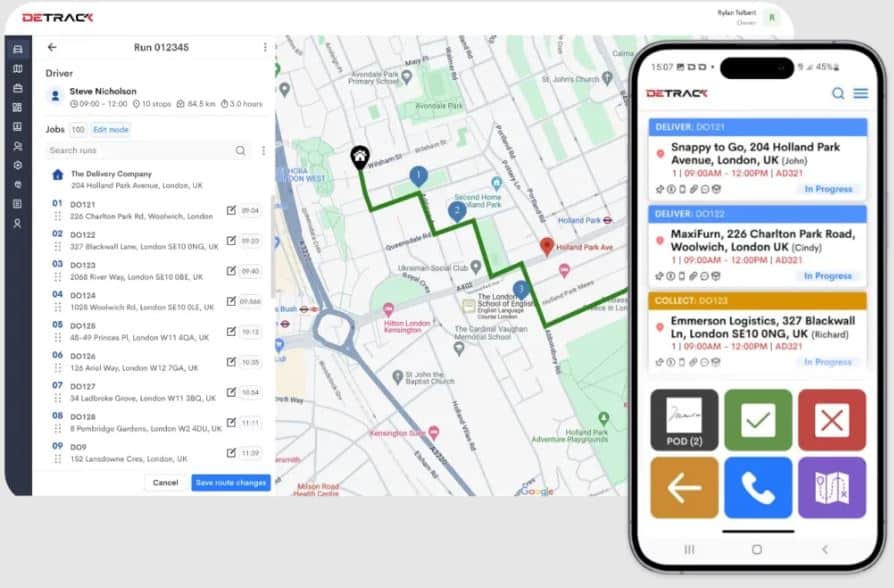When it comes to staying ahead of the competition, smart route planning is your secret weapon. In today’s fast-paced environment, efficient logistics and streamlined routes aren’t just about saving time and money – they’re about outpacing your competitors, keeping your customers happy, and ultimately growing your business.
Understanding the Basics: What is Route Planning?
Route planning is the process of determining the most efficient path for delivering goods or services to various locations. It considers factors like distance, traffic, delivery windows, and fuel consumption to optimize routes.
However, basic route planning is just the tip of the iceberg. To truly outpace your competitors, you need to elevate your approach and embrace smarter tactics.
Tactic 1: Leverage Advanced Technology
The days of manually plotting out routes on a map are long gone. Today, advanced technology is at the heart of smart route planning. Whether there’s an unexpected traffic jam or a last-minute delivery change, real-time tracking allows you to reroute your vehicles for optimal efficiency.
Artificial intelligence and machine learning can analyze vast amounts of data to predict the best routes. These systems consider historical traffic patterns, weather forecasts, and even driver behavior to suggest the most efficient paths. The more data the system processes, the smarter and more accurate it becomes.
Furthermore, specialized software can take into account numerous variables like delivery time windows, vehicle capacities, and road restrictions to automatically generate the most efficient routes. These route planning tools are designed to handle complex logistics, making it easier to manage large fleets and multiple deliveries.
Tactic 2: Embrace Predictive Analytics
Predictive analytics goes hand-in-hand with technology but deserves its own spotlight. By analyzing historical data, predictive analytics can forecast potential issues before they arise, allowing you to take proactive measures.
Imagine knowing in advance that a particular route is prone to heavy traffic on Thursday afternoons or that certain weather conditions might slow down deliveries. Predictive analytics provides these insights, enabling you to plan around potential delays and ensure that your operations run smoothly.
Additionally, predictive analytics can help you identify patterns and trends in your delivery operations. Are there certain areas where deliveries are consistently late? Is there a recurring issue with a specific vehicle? By identifying these patterns, you can take targeted action to improve your overall efficiency.
Tactic 3: Optimize Your Fleet
Efficient route planning isn’t just about the roads; it’s also about the vehicles on them. Your fleet plays a critical role in how well you can execute your route plans.
- Fleet Maintenance – Regular maintenance ensures that your vehicles are always in top condition, reducing the risk of breakdowns that can throw a wrench in your schedule.
- Vehicle Utilization – It’s not just about having a fleet; it’s about using it effectively. This means making sure that each vehicle is fully utilized to its capacity. Overloading can lead to inefficiencies and increased fuel consumption, while underloading can mean wasted resources. Smart route planning software can help distribute deliveries evenly across your fleet, maximizing efficiency.
- Driver Training – Even with the best technology, your drivers are the ones on the ground. Providing them with training on efficient driving techniques—like smooth acceleration, maintaining consistent speeds, and anticipating traffic flow—can significantly impact fuel consumption and overall delivery times.
Tactic 4: Adapt to Real-Time Changes
Flexibility is key in smart route planning. Even the best-laid plans can be disrupted by unexpected events. Whether it’s an unforeseen road closure, a sudden weather change, or a last-minute customer request, your ability to adapt quickly will set you apart from the competition.
- Dynamic Rerouting – Real-time GPS tracking combined with dynamic rerouting capabilities allows you to adjust routes on the fly. If a driver encounters a traffic jam or an accident, they can be redirected instantly, minimizing delays.
- Customer Communication – Keeping your customers informed about potential delays or changes in delivery times can improve their overall experience. Use technology to provide real-time updates, ensuring that customers aren’t left in the dark.
- Scalability – As your business grows, so will your delivery needs. Smart route planning systems should be scalable, allowing you to handle more deliveries and larger fleets without sacrificing efficiency.
Tactic 5: Monitor and Refine Your Strategy
Smart route planning isn’t a set-it-and-forget-it process. It requires constant monitoring and refinement.
Key performance indicators (KPIs) like on-time delivery rates, fuel consumption, and driver productivity provide valuable insights into the effectiveness of your route planning strategy.
Regularly reviewing these metrics can help you identify areas for improvement and make data-driven decisions.
Putting It All Together: Outpacing the Competition
All in all, smart route planning is a dynamic and ongoing process that blends technology, strategy, and adaptability! Are you ready to embrace it?



